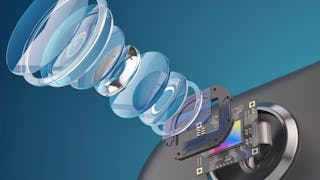This course focuses on the recovery of the 3D structure of a scene from its 2D images. In particular, we are interested in the 3D reconstruction of a rigid scene from images taken by a stationary camera (same viewpoint). This problem is interesting as we want the multiple images of the scene to capture complementary information despite the fact that the scene is rigid and the camera is fixed. To this end, we explore several ways of capturing images where each image provides additional information about the scene.


3D Reconstruction - Single Viewpoint
This course is part of First Principles of Computer Vision Specialization

Instructor: Shree Nayar
5,093 already enrolled
Included with
(39 reviews)
Recommended experience
What you'll learn
Learn radiometric concepts related to light and how it interacts with scenes.
Understand reflectance models and the different physical mechanisms that determine the appearance of a surface.
Develop a method for recovering the shape of a surface from its shading.
Understand the principle of photometric stereo where a dense surface normal map of the scene is obtained by varying the illumination direction.
Skills you'll gain
Details to know

Add to your LinkedIn profile
31 assignments
See how employees at top companies are mastering in-demand skills

Build your subject-matter expertise
- Learn new concepts from industry experts
- Gain a foundational understanding of a subject or tool
- Develop job-relevant skills with hands-on projects
- Earn a shareable career certificate

There are 6 modules in this course
What's included
8 readings2 discussion prompts8 plugins
What's included
1 reading7 assignments2 discussion prompts7 plugins
What's included
1 reading7 assignments2 discussion prompts7 plugins
What's included
1 reading6 assignments2 discussion prompts5 plugins
What's included
1 reading5 assignments2 discussion prompts4 plugins
What's included
2 readings6 assignments2 discussion prompts7 plugins
Earn a career certificate
Add this credential to your LinkedIn profile, resume, or CV. Share it on social media and in your performance review.
Instructor

Offered by
Explore more from Algorithms
 Status: Free Trial
Status: Free TrialColumbia University
 Status: Free Trial
Status: Free TrialColumbia University
 Status: Free Trial
Status: Free Trial Status: Free Trial
Status: Free Trial
Why people choose Coursera for their career




Learner reviews
39 reviews
- 5 stars
94.87%
- 4 stars
5.12%
- 3 stars
0%
- 2 stars
0%
- 1 star
0%
Showing 3 of 39
Reviewed on Sep 9, 2023
Interesting material popular explained. Good as entry point into the Computer Vision world
Reviewed on Jan 30, 2022
Excellent theoretical course, great content and the teacher explains very well. This course would be great with a complement of labs or small code practices.
Reviewed on Mar 26, 2023
Very a great theoretical course! beginners to best understand of cv

Open new doors with Coursera Plus
Unlimited access to 10,000+ world-class courses, hands-on projects, and job-ready certificate programs - all included in your subscription
Advance your career with an online degree
Earn a degree from world-class universities - 100% online
Join over 3,400 global companies that choose Coursera for Business
Upskill your employees to excel in the digital economy
Frequently asked questions
To access the course materials, assignments and to earn a Certificate, you will need to purchase the Certificate experience when you enroll in a course. You can try a Free Trial instead, or apply for Financial Aid. The course may offer 'Full Course, No Certificate' instead. This option lets you see all course materials, submit required assessments, and get a final grade. This also means that you will not be able to purchase a Certificate experience.
When you enroll in the course, you get access to all of the courses in the Specialization, and you earn a certificate when you complete the work. Your electronic Certificate will be added to your Accomplishments page - from there, you can print your Certificate or add it to your LinkedIn profile.
Yes. In select learning programs, you can apply for financial aid or a scholarship if you can’t afford the enrollment fee. If fin aid or scholarship is available for your learning program selection, you’ll find a link to apply on the description page.
More questions
Financial aid available,

